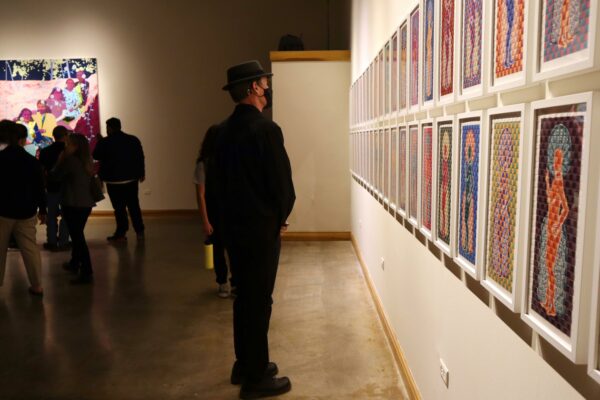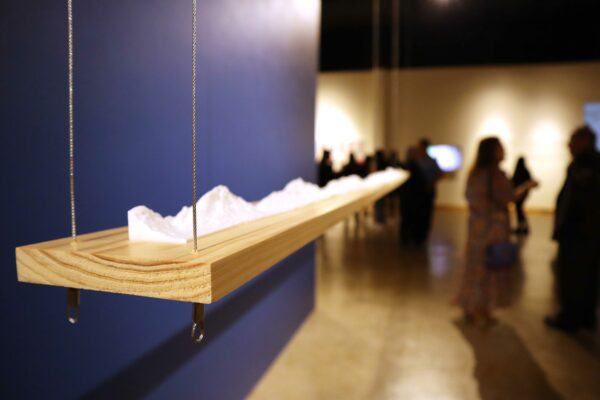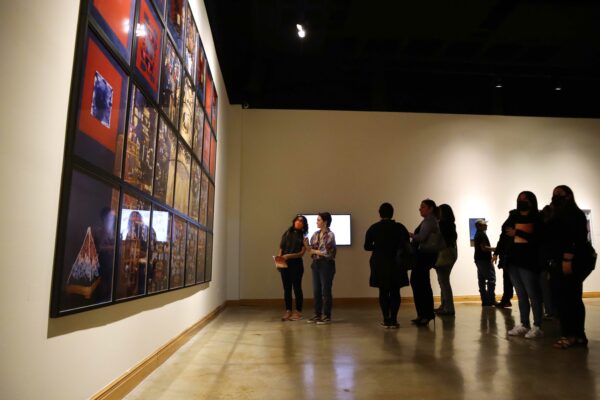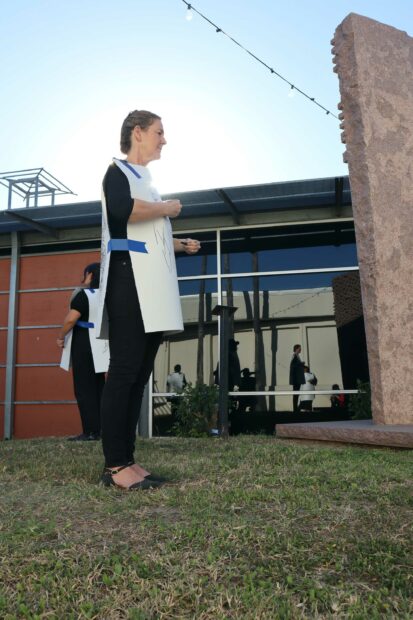
Photo from the opening reception of “Uncovered Spaces” at the International Museum of Art and Science in McAllen, Texas.
Uncovered Spaces is an exhibition that flexes the institutional muscles of the Rio Grande Valley. A collaboration between the University of Texas Rio Grande Valley and Vanderbilt University, and curated by Vanderbilt’s Raheleh Filsoofi, the show brings together a range of emerging to established artists who have exhibited in national and international contexts. The show has work by women, non-binary, and LGBTQIA+ folks, emphasizing the multiple institutional organizers’ roles in bringing diverse perspectives to the region. South Texas is deeply complex culturally, but in some ways is also hermetic. So, a show like this is very much welcome, bringing a wide confluence of visual languages that originate from elsewhere, but are presented for this specific place.
The show begins with a lead into visual vocabulary that is already familiar in border cities like McAllen. Entering the exhibition, the first work one encounters is Spaces in Between – Nopal (Rosa E De Los Santos) by Margarita Cabrera, who is based out of El Paso. The piece is a fabric nopal made of uniforms of border patrol agents and planted in a plain terra cotta pot. The green ripstop fabric has been cut apart and sewn together roughly as nopales, and its cloth fruits hang like protruding red tongues. According to the artist’s statement, the work portrays U.S.-Mexico border patrol agents as protagonists on its thorny leaves.
In the work, simple images depicting aspects of the lives of these agents are embroidered onto the nopales in multicolored threads. The simplicity of their expression is jarring, as some of these drawings portray the violence and death at the border with an economy of means. One nopal has a visa and a U.S. flag sewn on one side, with a border wall dividing it from a desert landscape with cacti, white cross-shaped grave markers, and two skeletons or bodies. The stark contrast between the plain, unadorned hand stitching and its portrayal of the deadly consequences of border crossings calls attention to the absurdity of a wall in the middle of a desert, the physical manifestation of political and historical violence, and the legacies of colonialism.
Another nopal depicts the ideological and psychological rewards for a border patrol agent, showing numerous figures standing hand-in-hand, with ‘USA’ and ‘Thank You’ sprawling across the top. Being in law enforcement requires psychological mechanisms to overcome the violence of the job, in the form of justification for the work on behalf of the State. Whether this is nationalism or gratitude, this is especially the case in South Texas, where many border patrol agents come from families who also have complex immigration histories, particularly with roots in Mexico. Cabrera channels these realities in the economy of her simple, neat, and arrhythmic stitching, which is full of beguiling depth.
Turning from the entrance to enter the exhibition space, one faces a video work by Zac Thompson, which makes itself known by its audible presence — a sound and video clip on repeat every minute or so. In the video, which is a performance recording of the artist, they start by sitting against the wall, wearing a dress and facial hair, and are brushing their hands against a charcoal architectural wall drawing of a home, leaving lines of their hand’s traces streaking across the surface. They perform against the sounds of a voicemail from their mother, in which she reads Florence Stetheimer’s poem, “Occasionally,” because she thought of them when she came across it. The poem’s words, “A human being / Saw my light / Rushed in / Got singed / Got scared / Rushed out / Called fire / Or it happened / That he tried / To subdue it / Or it happened / That he tried to extinguish it / Never did a friend / Enjoy it / The way it was…” as read by Thompson’s mother rings so true for many LGBTQIA+ folks, who often have to hide themselves in order to fit into society’s heteronormative frameworks. The recitation of the poem ends with “I turn on my light / And become myself,” alongside their mother’s words “I sure do love you” as she hangs up. Concurrently, the artist’s own journey across the wall’s drawing reaches its end at the bathroom, which is bathed in the last pink glow from a rainbow series of lights above the drawing. It is a poignant work about empathy, and their family’s acceptance of the artist’s queer identity.

Photo from the opening reception of “Uncovered Spaces” at the International Museum of Art and Science in McAllen, Texas.
Using photography, video, and ceramics, Natalia Arbelaez has created a series of works around the myths of El Dorado, or El Rey Dorado, a legendary tribal king of the Muiscas who is said to have walked into a lake covered in gold dust. This figure is embodied by the artist herself, with recurring imagery of a gold goblin-like face. Two goblin-faced clay vessels (with sharp teeth!) that look partly like Native American marriage vessels, or perhaps like barbells, draw in the viewer. Their dreamy gold surfaces are pressed with hundreds of nimble finger markings that look like flower petals have been pressed onto them. In their shine and their shape, they speak of celestial bodies and their connection to spirituality in the form of a mythical being who originates from eons-old tales.
In one of her photo works — a series installed adjacent to the clay pots — the artist wears a gold goblin mask herself, and she is buried in a round hole with four terracotta pots and the two gold barbells on display. The figure, wearing a white dress, looks asleep — resting in an indentation in the earth — and fragile, like the round pots that surround her. The artist uses chiaroscuro-like light and shade, with the ground around the dig strewn about with loose earth, patchy dark green grass, and raised green brush. In another photo, she is wading into a lake wearing a gold tankini, her body covered in gold paint, remaking the legend of El Rey after her own figure.
A video self-portrait of the artist, in which she assumes the same identity in gold, is also installed on the adjoining wall. In it, the dancing figure of the artist is zooming in and out, dividing into nine figures, and flashing across the screen. At some moments she is a bright white silhouette coming toward the viewer, and all throughout hand-drawn stars sprinkled around the screen slowly float toward the screen, as though one is traveling through space and has just happened across this mythical goblin figure. In her movements, Arbelaez gently and hypnotically bounces her hips and knees, in the same way babies learn to dance in an elemental response to music. The artist is recreating her own myth out of the archeological documents and oral histories about Colombia, her parents’ native country. It is a burial, a ritual, and a celebration of a newfound identity and its expansive possibilities.
Erica Diamond’s extraordinary work is a sheer, long-sleeved, collared women’s shirt with quarter-sized pieces of brown eggshells carefully sewn between two layers. The details of the delicate work makes one reexamine eggshells, a mundane material for compost, that here take on hypnotizing qualities. The matte gloss of the gently curved shells is clay-like, and sewn together, the surface of the shirt looks prehistoric and uncanny, like manifestations of featherless dinosaur skins. A prominent sign next to the shirt reads “Do Not Touch Artifacts.” Diamond’s piece is reflective of the fragility of queer experience. Going through multiple levels of social trauma is a typical experience of many queer folks, and wearing this delicate piece would be like an armor, as it’s hard to imagine being the person to destroy its pristine, otherworldly beauty. The shirt is eventually meant for a pending performance where it will be worn while the artist is hugged, and will thus assume the traces of the other body that envelopes the wearer of the shirt.
Wendy Red Star’s photographic work Apsáalooke Feminist #2 captures the artist and her daughter, Beatrice, her artistic collaborator. They both wear traditional Apsáalooke (Crow) elk tooth dresses, which “specifically symbolizes Crow womanhood and the matrilineal line,” according to the artist’s statement. They are in traditional Crow makeup, painted with red accent marks at the top edge and the sides of their faces, and their lips are colored bright red. They are adorned with Crow beaded ornaments, which their tribe is especially well known for, including headbands, bracelets, purses, belts, and earrings, each depicting patterns and significant family and social symbols like flowers and horses.
One of the interesting aspects of this particular series by the artist is that they are also wearing and are surrounded by indigenous crafts and clothing from various origins and cultures, including Crow, Southwest, and non-indigenous, contemporary patterns. They sit on a couch draped with a Navajo chinle pattern rug alongside a couple of contemporary patterned ones; the artist wears a Zuni cluster-pattern turquoise jewelry, and her child wears a pink star patterned shirt. Altogether the pair embody and display contemporary indigeneity, testing the viewer’s knowledge and range of indigenous artmaking. The two figures look steadily at the viewer, each with their hands joined at their chins — the artist’s daughter leans toward her mother in warm proximity. They seem to ask the viewer, “who do you see? How do you see us?” The manipulated zig-zag stripes on the walls and the floor of the gallery are digitally manipulated patterns reminiscent of Navajo banded saddle blankets, and seem to mirror the stretch of knowledge required to read the piece. Often, indigenous artists are tasked with educating the public, as indigenous history is sorely missing in public education for the most part. This work seems to throw this fact back at the viewer, as a challenge.

Photo from the opening reception of “Uncovered Spaces” at the International Museum of Art and Science in McAllen, Texas.
María Magdalena Campos-Pons presents a large composite self-portrait made up of 28 panels of photos. In it, she is surrounded by what she imagines to be her Chinese ancestry. She wears a crude version of a Qing Dynasty imperial dragon robe and is surrounded by empty bird cages and small ceramic vessels based on Ming Dynasty blue and white porcelain. Her face and skin is caked with a crumbling mixture in platinum white, and her lashes are painted in light blue, straight out of a campy 1980s Hong Kong jiangshi (zombie) horror movie. Originally from Cuba, her family has Nigerian, Hispanic and Chinese origins, and in the show, she presents this work exploring her Chinese ancestry, which she has referred to in the past as “a tradition in which I have an investment in, but not the artistic dexterity.” The pastiche forms of Chinese art history that she has packed into the frames are altogether presented by the artist in a very serious way, as though it is history itself — a kind of a slap in the face in their hollowness.
According to the artist, her mother’s father had ancestry from the transatlantic slave trade and Chinese indentured servitude, with the latter being part of the complex hidden histories of Cuba. The artist only found out that her family’s Chinese roots likely came from Canton when she proposed this work as part of the Guangzhou Triennial in 2008; the clue came from the ceramic vessels the artist had incorporated into the work. That she reimagines this part of her culture and heritage using this photographic, defragmented anti-historical theatre speaks to the surreal role of history in the context of slavery and servitude in the legacies of Caribbean sugar plantations.

Jana Harper performing at the opening of “Uncovered Spaces” at IMAS International Museum of Art and Science in McAllen
Other works in Uncovered Spaces include Maria Fernanda Barrero’s obsessive and beautiful capturing the coils of storm clouds with threads; Vesna Pavlovic’s poignant yet decontextualized and altogether aloof analog slide projections; Jana Harper’s transient video works capturing multiple iterations of performances by people memorializing names on concrete pavement, using water as it evaporates; Daisy Patton’s paintings reanimating lost photographs; Lauren Sandler’s obsessive ceramic vessels emulating collections of mundane objects; and Linda Behar’s woven fiber works celebrating women’s bodies. They are all part of this collection of visual language celebrating the wide experiences of women and queer folks. This exhibition is altogether resistant, welcoming, protective, and liberating, while refusing to be pedantic — it ultimately leaves the interpretation of these works to the viewer, to absorb and to relate back to their lives here, in South Texas.
Uncovered Spaces is on view through July 10 at the International Museum of Art & Science in McAllen, Texas.


